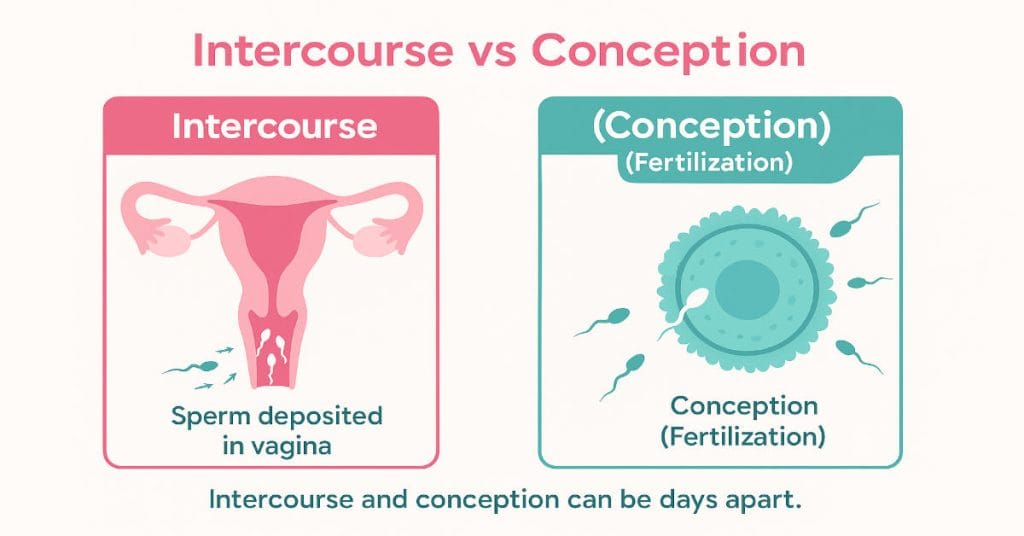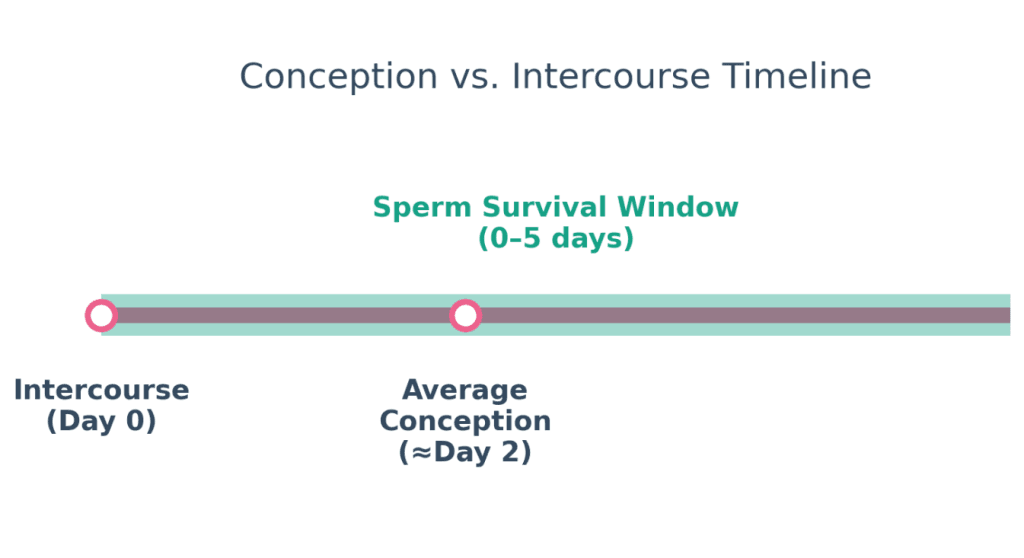Trying to pinpoint your due date from a specific event? Whether you know the date of intercourse or your estimated conception date, our calculator accounts for key biological factors to give you the most accurate possible timeline.
Birth Probability Calendar
Pregnancy Progress
Current Status
Key Dates
A Note on Accuracy: Why Intercourse Date ≠ Conception Date
Many online calculators make the mistake of treating the date of intercourse and the date of conception as the same thing. This is not biologically correct. Sperm can live for up to 5 days inside the body, meaning conception (fertilization) can happen several days after intercourse.
Our tool is more accurate because it correctly models this delay by adding an average 2-day period between intercourse and conception, providing a more realistic due date estimate.
If you prefer to work from your last menstrual period instead of an intercourse date, use our main baby due date calculator.

How to Use This Calculator & Read Your Results
Our tool is designed to be simple to use and provide a rich, detailed timeline. Here’s how to get your results in just a few steps.
- Choose Your Method: Select whether you know your Intercourse Date (the default) or your Conception Date using the toggle at the top.
- Enter Your Date: Click the input field and use the calendar to select the specific date you have in mind.
- Calculate Your Timeline: Click the "Calculate Due Date >" button.
- Explore Your Results: Your full, personalized timeline will appear, including your estimated due date, pregnancy progress, and the interactive Birth Probability Calendar.

Understanding Your Birth Probability Calendar
Only about 4% of babies are born on their exact due date. Our interactive calendar gives you a much more realistic picture by showing the statistical likelihood of birth for each day surrounding your due date.
- The Colors: The calendar uses a color gradient to show the Likely Birth Window. Lighter pink shades indicate a lower but increasing chance, while the vibrant, darker pinks highlight the days with the peak probability of going into labor.
- The Percentages: Each day in the window shows a percentage. This is the statistical probability of giving birth on that specific day based on large-scale population data.
- The Due Date: The green square marks your Est. Due Date. This is the single day with the highest statistical probability and the center of your "peak week."
The Science: From a Single Day to a Full Timeline
Calculating a due date from a specific event requires a more nuanced approach than just simple addition. Our calculator uses a clinical model based on key biological milestones.

- If you enter a Conception Date: This is the most direct method. We simply add 266 days (38 weeks) - the standard length of a pregnancy from conception to birth - to find your estimated due date.¹
- If you enter an Intercourse Date: This is where our calculator stands out. We first account for the fact that sperm can survive for up to 5 days and fertilization doesn't happen instantly. We estimate your conception date to be approximately 2 days after intercourse. From that more realistic conception date, we then add 266 days to calculate your final due date.
Frequently Asked Questions
Which input method is more accurate?
Entering a known "Conception Date" (for example, from an IVF procedure) will be the most precise. However, entering your "Intercourse Date" is a very strong estimate, and our calculator's model is designed to give you the most likely outcome.
What if I had intercourse on multiple days?
For the most accurate estimate, enter the earliest date of intercourse that occurred within your fertile window. Our calculator's model, which accounts for sperm survival, will provide the best timeline based on that information.
Why shouldn't I just add 280 days to my intercourse date?
This is a common mistake. The 280-day (40-week) pregnancy length is measured from your Last Menstrual Period (LMP), not from intercourse or conception. Calculating from conception requires using the fetal age of 266 days (38 weeks), which our tool does automatically.
What if I don't know my intercourse or conception date?
No problem! Our main Due Date Calculator allows you to calculate your due date from your Last Menstrual Period (LMP), which is the most common and reliable method for most people.
Methodology and sources
What this calculator estimates
This tool assumes that a pregnancy has already started and uses either an intercourse date or a conception date to estimate:
- an estimated due date (EDD),
- current gestational age and trimester,
- a simple fetal size estimate, and
- a birth probability calendar around the due date.
It does not predict whether pregnancy will occur from a given act of intercourse.
Obstetric dating rules used
Standard obstetric dating counts gestational age from the first day of the last menstrual period (LMP). A typical pregnancy is treated as about 280 days from LMP and about 266 days from conception. The calculator follows the same convention:
- If you enter a conception date, the tool sets a “clinical LMP” 14 days earlier and sets the due date 266 days after conception (equivalent to LMP + 280 days).
- If you enter an intercourse date, the tool assumes conception happens about 2 days later for a typical cycle, then applies the same 266-day interval from that estimated conception date.
These rules match common clinical guidance on due date calculation from professional bodies and textbooks.
Gestational age and pregnancy progress
Once the clinical LMP is set, gestational age today is calculated as the number of whole days between that LMP date and today. The tool then:
- converts days to weeks and extra days for the “weeks into pregnancy” field,
- classifies trimester as:
- First trimester: up to 12 weeks 6 days,
- Second trimester: 13 weeks to 26 weeks 6 days,
- Third trimester: 27 weeks and beyond,
- computes “percent complete” as days since clinical LMP divided by the total days between clinical LMP and the due date, capped between 0 and 100 percent.
Fetal length and weight estimates
The fetus length and weight numbers are approximate averages. The calculator uses a smoothed look-up table of typical crown–rump or head-to-heel length and estimated weight by gestational week from widely used growth charts and clinical summaries. For:
- very early pregnancies (before about 8 weeks) the tool reports zero, because routine charts are less consistent in that range,
- later weeks, it linearly interpolates between table points so that length and weight change smoothly from week to week.
These values are for general orientation and are not a replacement for ultrasound-based growth assessment.
Birth probability calendar
Most spontaneous births occur in the few weeks around the due date, not exactly on that day. To show this spread, the calculator:
- anchors the calendar to the estimated due date,
- applies a fixed probability curve that assigns small probabilities several weeks before and after the due date and a peak around the due date itself, and
- maps those probabilities to colours and percentages for each calendar day.
The percentages are normalised so they sum to 100 percent across the displayed window. They represent the relative likelihood of birth on each day for a typical term pregnancy, not personalised odds for you.
Pregnancy test timing
For the “reliable positive pregnancy test” date, the tool marks a day 14 days after the conception date estimate. This reflects that:
- urine pregnancy tests are most accurate around the time a period is due or shortly after, and
- many clinical and patient resources advise testing from about 2 weeks after ovulation or conception, with higher accuracy after a missed period.
Limits and cautions
This calculator uses population averages and simple rules. It does not adjust for:
- variations in cycle length or ovulation timing in a specific cycle,
- early ultrasound measurements that your clinician may use to refine dating,
- assisted reproduction protocols, embryo stage, or transfer day,
- multiple pregnancy, medical conditions, or pregnancy complications.
The dates and probabilities are for general education only. They are not medical advice and are not suitable for legal, insurance, or paternity decisions. Always discuss your own dates, scan findings, and birth planning with your clinician.
Sources
Guidance and data that inform this calculator include:
- American College of Obstetricians and Gynecologists. Committee Opinion No. 700: Methods for estimating the due date. PubMed summary.
- Wilcox AJ, Dunson D, Weinberg CR, Trussell J, Baird DD. Timing of the fertile window in the menstrual cycle. New England Journal of Medicine. 1995;333(23):1517–1521. Full text.
- Cleveland Clinic. Pregnancy tests: blood tests, urine tests, and how early they work. Patient information.
- Background material on typical gestational length and the distribution of spontaneous birth around the due date, as summarised in standard obstetric texts and reviews (for example articles discussing Naegele rule and natural variation in human gestation).
Medical disclaimer
The information and calculators on this site are educational tools only. They provide statistical estimates based on published research and the details you enter.
They cannot diagnose, predict what will happen for you, or replace personalized advice from a licensed health care professional who knows your full history. Always talk with your doctor, midwife, or other qualified clinician before making decisions about your health, fertility, or pregnancy.
Never ignore, avoid, or delay seeking professional medical advice because of something you read here or a result you see in a calculator. If you think you may be having a medical emergency, call 911 in the United States or your local emergency number.
- American College of Obstetricians and Gynecologists. Committee Opinion No. 700: Methods for estimating the due date. Obstetrics and Gynecology. 2017. View guidance.
- Thangaratinam S, Arulkumaran S, and colleagues. Antenatal care. StatPearls. NCBI Bookshelf. Chapter overview.
- Cleveland Clinic. Pregnancy tests. Diagnostic test explainer.
